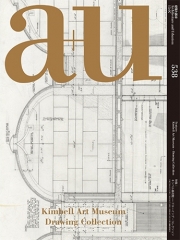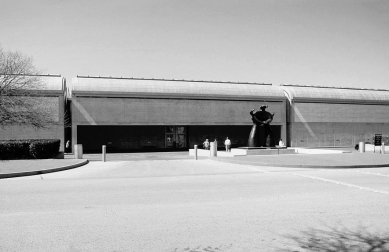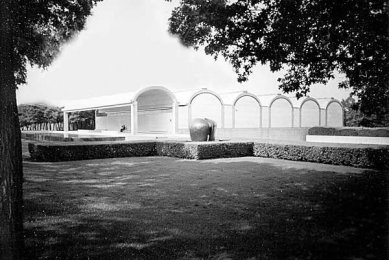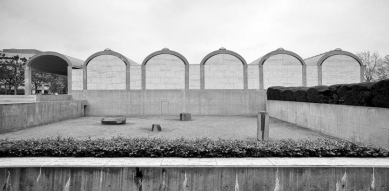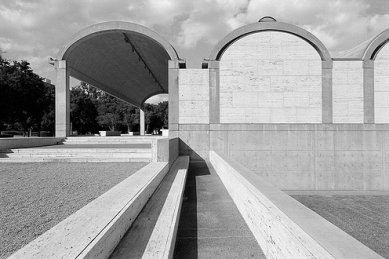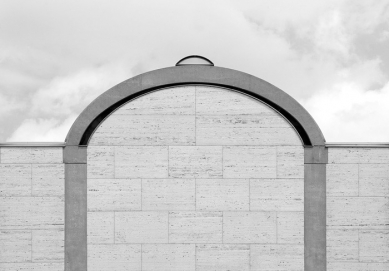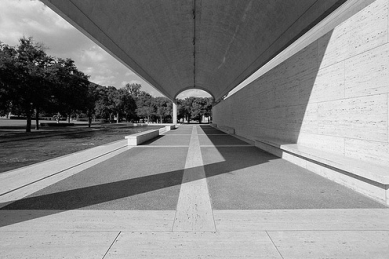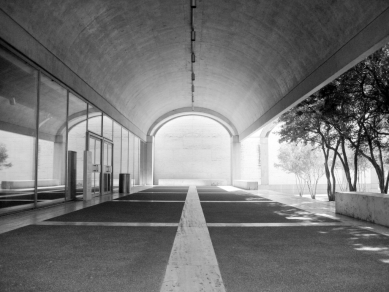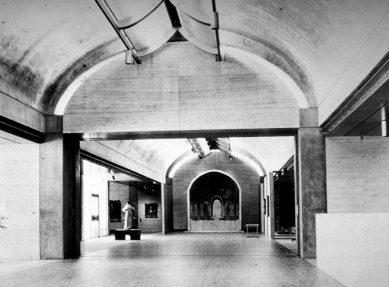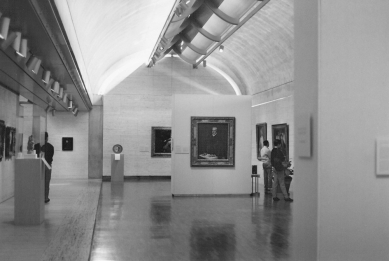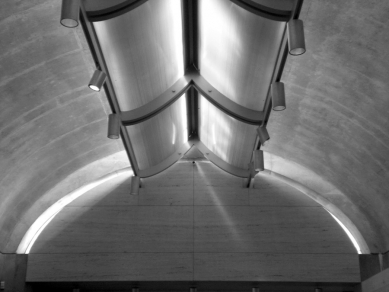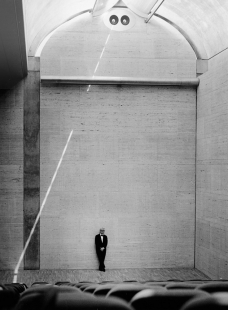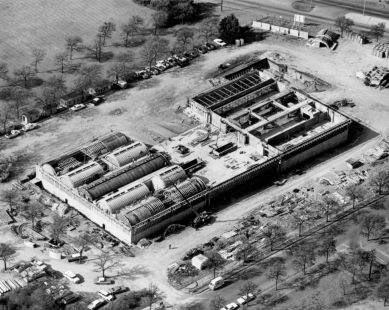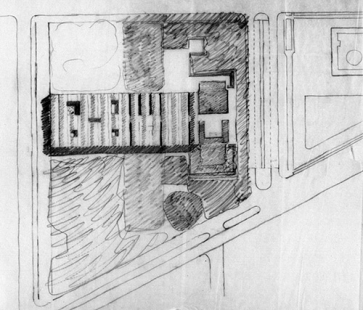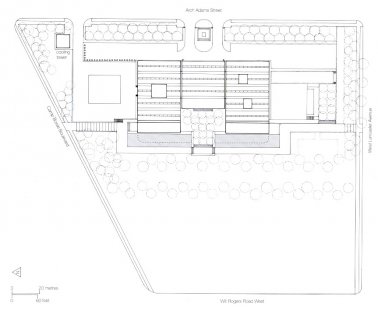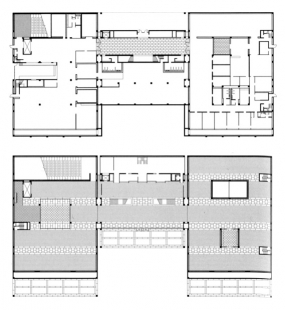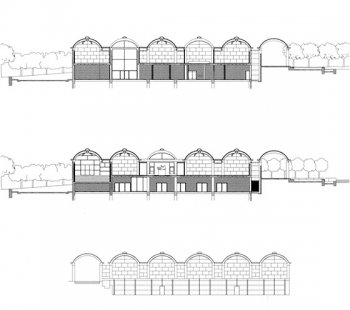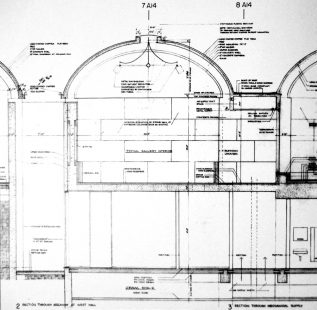
Kimbell Art Museum

"A museum seems secondary unless it is itself a great treasury. A treasury lovingly guarding your resources. Oh, what a place that would be! Not for cramped accumulation. You walk through halls and halls and more halls. The Cairo Museum is a cramped building that looks more like a warehouse than a museum. A museum should be able to spread out. The first thing you want in a museum is to have a cup of coffee. You immediately feel tired. A museum needs a garden. You step into the garden and you can return or not. A large garden will tell you that you can enter and see things or you can leave. Totally freely. You are not forced to enter. You come to see one thing or you are seized to see it and all of this is part of visual history, an immeasurable sense.”
The Kimbell Art Museum in Texas houses a significant permanent collection, hosts a number of traveling exhibitions, and provides space for a renowned academic library, but the main focus is the museum's very object, demonstrating structural restraint, operational logic, and an aesthetics derived from classical Greek buildings.
The first collection was donated to the museum by the Kimbell couple, after whom the museum is named. Kay Kimbell was a wealthy industrialist who, through his wife Velma, became interested in art and left a collection amassed over thirty years to a foundation upon his death, which is now regarded as a selection of 'the best old masters in the southwestern United States.' The Kimbells, in addition to their estate, also bequeathed funds necessary to build a new 'first-class museum.' Foundation director Richard F. Brown advocated for the museum to be as much a work of art as the pieces exhibited inside. In places where three museums had stood before, Brown purchased nearly ten acres of land and drafted a comprehensive building program. For the client, the main role was played by natural lighting. The resulting form was to remain understated so as not to overwhelm the exhibited works or distract visitors. The most prominent creators of their time were invited for an interview: Marcel Breuer, Ludwig Mies van der Rohe, Pier Luigi Nervi, Gordon Bunshaft, Edward Larrabee Barnes, and ultimately, in October 1966, Louis I. Kahn was commissioned from the array of renowned architects. At that time, Kahn was known not only for his outstanding realizations but also for delays and financial overruns in his buildings; therefore, local architect Preston M. Geren was appointed to oversee everything, resulting in mutual conflict between the two architects. The building was completed in October 1972 and immediately garnered wide admiration and respect. The new museum was created on a slightly sloping site below the Amon Carter Museum, while the entrance terrace faces Fort Worth. Kahn was asked to ensure that the museum did not exceed 40 feet (12 meters) in height so as not to obstruct the view from the Carter Museum to the city. Kahn’s initial design was low but conceived as a generously proportioned square with a side length of 450 feet (137 meters). In subsequent iterations, the final form was reduced to sixteen identical parallel vaults (30 m long, 6 m high, and 6 m wide). The resulting vaults are arranged into three wings. The northern and southern wings each contain six vaults. The western wing opens into a covered outdoor colonnade. Louis Kahn achieved an astonishing interior space with silvery natural light coming from the top of the vault through the repetition of visually powerful vaults with lead coverings. A simple grid of concrete columns topped by the vaults is filled with travertine walls. Kahn’s sense for timelessness always stems from respect for the material and attention to detail. The individual parts exhibit mutual respect and together create a harmonious whole. Kahn masterfully utilized any material and achieved perfection even with significant financial constraints.
Louis I. Kahn
P.C.Loud: The Art Museums of Louis I. Kahn, Duke University Press, Durham 1989, p.231
P.C.Loud: The Art Museums of Louis I. Kahn, Duke University Press, Durham 1989, p.231
The Kimbell Art Museum in Texas houses a significant permanent collection, hosts a number of traveling exhibitions, and provides space for a renowned academic library, but the main focus is the museum's very object, demonstrating structural restraint, operational logic, and an aesthetics derived from classical Greek buildings.
The first collection was donated to the museum by the Kimbell couple, after whom the museum is named. Kay Kimbell was a wealthy industrialist who, through his wife Velma, became interested in art and left a collection amassed over thirty years to a foundation upon his death, which is now regarded as a selection of 'the best old masters in the southwestern United States.' The Kimbells, in addition to their estate, also bequeathed funds necessary to build a new 'first-class museum.' Foundation director Richard F. Brown advocated for the museum to be as much a work of art as the pieces exhibited inside. In places where three museums had stood before, Brown purchased nearly ten acres of land and drafted a comprehensive building program. For the client, the main role was played by natural lighting. The resulting form was to remain understated so as not to overwhelm the exhibited works or distract visitors. The most prominent creators of their time were invited for an interview: Marcel Breuer, Ludwig Mies van der Rohe, Pier Luigi Nervi, Gordon Bunshaft, Edward Larrabee Barnes, and ultimately, in October 1966, Louis I. Kahn was commissioned from the array of renowned architects. At that time, Kahn was known not only for his outstanding realizations but also for delays and financial overruns in his buildings; therefore, local architect Preston M. Geren was appointed to oversee everything, resulting in mutual conflict between the two architects. The building was completed in October 1972 and immediately garnered wide admiration and respect. The new museum was created on a slightly sloping site below the Amon Carter Museum, while the entrance terrace faces Fort Worth. Kahn was asked to ensure that the museum did not exceed 40 feet (12 meters) in height so as not to obstruct the view from the Carter Museum to the city. Kahn’s initial design was low but conceived as a generously proportioned square with a side length of 450 feet (137 meters). In subsequent iterations, the final form was reduced to sixteen identical parallel vaults (30 m long, 6 m high, and 6 m wide). The resulting vaults are arranged into three wings. The northern and southern wings each contain six vaults. The western wing opens into a covered outdoor colonnade. Louis Kahn achieved an astonishing interior space with silvery natural light coming from the top of the vault through the repetition of visually powerful vaults with lead coverings. A simple grid of concrete columns topped by the vaults is filled with travertine walls. Kahn’s sense for timelessness always stems from respect for the material and attention to detail. The individual parts exhibit mutual respect and together create a harmonious whole. Kahn masterfully utilized any material and achieved perfection even with significant financial constraints.
The English translation is powered by AI tool. Switch to Czech to view the original text source.
0 comments
add comment


